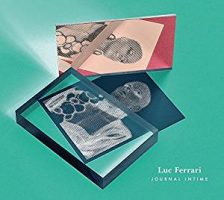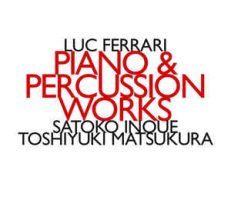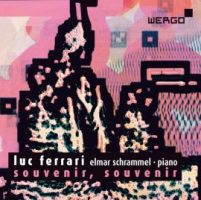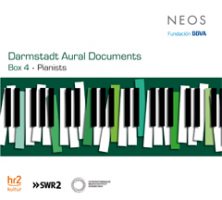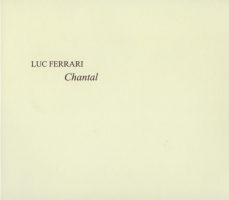Ferrari Heteroclite and Obscure
|
Grant Chu Covell [July 2017.] When listening to most composers, hearing a previously unknown piece completes a picture. Perhaps we hear something which chronicles an apprenticeship or demonstrates a mature culmination. It’s rarer that a previously unheard work shakes up our conception. In this batch, Journal Intime and Chantal challenge an understanding of Ferrari’s worldview and work.
Luc FERRARI: Journal Intime (1980-82; vers. Testklang, 2015). Rei Nakamura (pno), Sarah Maria Sun (sop), Lisette Malidor (speaker). Testklang TK1105 (1 CD) (http://www.testklang.net/). Ferrari’s Journal Intime began life as music theatre with piano, actress, vocalist and tape. The texts are taken from the composer’s diaries. Some of the piano music was written contemporaneously and there are bits and pieces of other things Ferrari had been working on at the time. Somewhat later, Ferrari extracted a piano suite, Fragments d’un journal intime (1980-82), but for the most part the original formation had never been recreated until now. (The piano solo Fragments has been variously recorded.) The good folks at Testklang consciously sought to transplant the theatre experience into a sound recording, taking sensible liberties with balance and content. What we hear is most likely very different from what was performed on stage at the Musée d’Art Modern, in Paris, April 1982. Ferrari wrote about sexuality and identity, artistic creation, and the forces of power in our culture. His voice from the original tapes appears now and again. If a theme emerges, it is the reinforcement that Ferrari was all about exposing contradictions. We hear how, when Ferrari composed, he believed he was exploring his feminine side. There are also ruminations on taking action and enjoying laziness. The piece winds up, then gradually diffuses, spent but wiser. It is autobiographical and anecdotal. The piano music may be familiar from the suite. The material in Introduction appears more fragmented here, perhaps because Ferrari abridges it during repetitions, thwarting development. The music can be mechanical or wistful. The aggressive style owes a bit to Bartók, as well as the way two contrasting types of material may wrestle in alternation. Satie is not too far away, though Ferrari is more earnest. It does seem that this is one of Ferrari’s most serious and honest endeavors. It makes sense that this Cortot student would play Chopin nearly every day. Ferrari’s great orchestral symphony, Histoire du Plaisir et de la Désolation (1979-81), dates from the same period, and Testklang artfully cites relevant sections. There’s a description of how a theme prominent in the last movement appeared during a moment of boredom. We also hear bits from the radio play Jetzt (1981-82) and the score for the film Chronopolis (1981-82). Journal Intime parallels the harmonic and conceptual conflicts underlying Histoire du Plaisir et de la Désolation, and not just because the theme from the final section also appears in Journal Intime. A downloadable booklet offers complete French texts and translations in English and German interspersed with score pages. Purchasers of the release can also download a necessary explanatory hour-long film, Luc Ferrari – Journal Intime.
“Piano and Percussion Works.” Luc FERRARI: Conversation Intime (1987-88)1; Visage I (1956)2; Sonatine Elyb (1953-54)3; Cellule 75 – Force du rythme et cadence forcée (1975)4. Satoko Inoue1,2,3,4 (pno), Toshiyuki Matsukura1,4 (perc). Hat Art hat[now]ART 165 (1 CD) (http://www.hathut.com/). This collection reminds that Ferrari began like many postwar composers, first plunging into but then fleeing the serial pool. Visage I and Sonatine Elyb reflect the prevalent style, though Visage I suggests that Ferrari’s mind would inevitably drift elsewhere. It is a mystery what “Elyb” means (probably not Google’s first hit: East Lyme Youth Basketball). This 2010 release suggests it is the first recording, although Schrammel’s June 2010 recording on Wergo WER 6737 2 is not far behind. Written while attending Messiaen’s classes, the composer premiered the three short movements in Darmstadt, in 1956. Visage I combines serialism with repetition, and Ferrari’s particular use of cellular repetition would become one of his favorite techniques. The program begins with the duo Conversation Intime. The piano part idles with jazz, and it can startle when the percussionist switches from cool vibes to harsh drums. The duo’s assertive moments could be lifted out of Bartók, perhaps a reflection of Ferrari’s own experience as a pianist. Until now, I had not realized the title’s possible pun: “Conversation in time.” Elisabeth Chojnacka and Sylvio Gualda’s 1990 version on ADDA 581224, for harpsichord and percussion, is not incredibly different, despite the harpsichord’s brittleness and Gualda’s mellower sounding vibes. Inoue and Matsukura are slower (19:40) compared to Chojnacka and Gualda (17:20). Inoue’s piano establishes a firmer harmonic basis, perhaps because of pedaling. At 32:45, Cellule 75 – Force du rythme et cadence forcée provides an enormous conclusion. Inoue and Matsukura are well matched, assertively reacting to the tape. They never seem to be surprised by the fixed media. Some examples: the factory / mechanical section near the center (starting ca. 11:20) is cleanly mirrored in the piano and percussion, and there’s a playfulness at the military march parody. In the notes, Inoue relates that Ferrari had images in mind for the sections. By comparison, Paul Dubuisson, piano, and Pablo Cueco, percussion, require 25:14 (ADDA 581010 from 1986, with 23 pieces from the Collection de petites pièces; Dubuisson took part in Journal Intime’s premiere). It does sound like Dubuisson and Cueco’s tape spools slightly faster, and as they generate their motives, the opus grows minimal, less of an interactive trio compared to Inoue and Matsukura’s handling. One of the welcome aspects to Chris Brown and William Winant’s 1998 Tzadik release (TZ 7033, with the tape opus Place des Abessess) is the miniaturized and barely legible copy of the score’s first page. Their version is 31:17 and Brown works the piano material briskly.
“Souvenir, souvenir.” Luc FERRARI: Suite Hétéroclite (1954-55); Antisonate (1953); Sonatine Elyb (1953-54); Visage I (1956); Collection de petites pièces ou 36 enfilades pour piano et magnétophone (1984-85); Fragments d’un journal intime (1980-82). Elmar Schrammel (pno). Wergo WER 6737 2 (1 CD) (http://www.wergo.de/). On the surface, two Ferraris are displayed here: the schooled pianist who studied with Cortot and then explored serialism, and the globetrotting trickster with a portable tape recorder. Ferrari railed against form with the aptly titled Antisonate, yet the Sonatine Elyb is serial. The seven-part Suite Hétéroclite was written at sea while travelling to meet Varèse in New York, but little suggests travel or the ocean; instead the Suite is an abstract, aphoristic collection. There would be four more Visages: three for instrumental combinations, and then Visage V (1958-59) for tape. The jump to the Collection may startle. The tape recorder had become one of Ferrari’s most important tools, and with it, new ways to remind of the past and link associations. Collection’s piano part may seem frivolous, with its apparent simplicity and frequent quotes of standard repertoire (Beethoven, Strauss, Liszt, et al.). Much of the tape part is goofy, with sound effects and slapstick, a woman’s voice with suggestive exhortations, Ferrari himself, etc., but the content in the 36 short moments (actually 35, but that’s another Ferrari trick) starts to repeat, and immediately we confront what we’ve heard before as well as things heard before the piece even started. “Theme and Variations” as a genre is invoked explicitly, and Ferrari tries his hand at Schumannesque and Brahmsian treatments of one of the recurring pithy motives. Dark drama occurs at the end, first in the form of something like a movie outtake with a woman’s voice over a telephone and atmospheric piano music (tape only), then the concluding finale which pits piano against tape. Schrammel offers two movements from Fragments d’un journal intime: a bit of seriousness to conclude a frivolous center. The titles suggest stories lurk beneath: “Ce mystérieux moment” and “‘Regarde mon corps’ dit-elle,” but having heard their siblings in Journal Intime isn’t helpful. Eight movements of Fragments appear on the 1997 Auvidis Montaigne release MO 782110 where Christine Lagniel and Michel Maurer traded off solo piano works and joined together for the two-piano Comme une Fantasie dite des Réminiscences (1989-91). Unlike Wergo’s release, Antisonate’s three parts are tracked separately. In 2003, Maurer recorded Collection for l’empreinte digitale ED 131711 (joined with percussionist Françoise Rivalland in Jeu du hazard et de la determination [1998-99]) on a less rich instrument. The booklet helpfully lists which tracks are piano, tape, or piano plus tape.
“Darmstadt Aural Documents. Box 4. Pianists.” Var comps., incl. Luc FERRARI: Visage I (1956). Else Stock-Hug (pno). Neos Music NEOS 11630 (7 CDs) (http://www.neos-music.com/). Obviously the collector will snap up this seven-disc set for lots of reasons, not just because of the July 20, 1957 performance of Ferrari’s Visage I on disc two. Sandwiched chronologically between Evangelisti and Stockhausen, with near neighbors B.A. Zimmermann, Boulez, Clementi, Castiglioni, et al., underscores how Ferrari took to heart serialist doctrine but yearned for more. Visage I is definitely more personable than Klavierstück XI.
Luc FERRARI and Brunhild MEYER-FERRARI: Chantal, ou le portrait d’une viollageoise (1977-78). OHM Éditions ohm 051 (1 CD) (http://avatarquebec.org/). A drop of water randomly flicked upon a map determined where Luc and Brunhild went on vacation in 1976. In Tuchan (Corbières) they met Chantal who told them of her life. There are musical interjections, but for the most part we hear conversation, and unless you’re fluent in French, this is perhaps for Ferrari obsessives only. The work is perhaps best experienced radiophonically. It is a skillful collage of field recordings made that summer, of conversations and perhaps other things which Luc and Brunhild experienced. Most of the music originates from guitar, perhaps captured that summer in Tuchan.
[More Grant Chu Covell]
[More
Ferrari, Meyer-Ferrari]
[Previous Article:
Élie Cohen and Georges Truc: Obscure Conductors]
[Next Article:
Used Bin Troll Tweets AA.]
|
